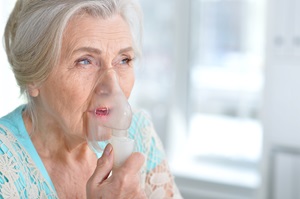All About Nebulizers

Ready to manage your COPD from the convenience of your own home? If the answer is “yes,” then it’s time to learn about nebulizers.
Nebulizers are electric- or battery-powered devices that turn liquid medicine into mist, making it easier for COPD patients to inhale medicine into their lungs.
Unlike inhalers, nebulizers are not easy to carry around. They include a machine that pushes air through a tube, a small medicine container and a mask or mouthpiece. Therefore, most patients keep their nebulizers at home.
Nebulizers can deliver a range of medicines to manage symptoms for COPD patients, including:
- Bronchodilators – Medicine that is inhaled and causes airways in the lungs to open up
- Corticosteroids – Medicine that lowers inflammation (a condition that can cause swelling, heat and pain)
- Antibiotics – Medicine that stops infections caused by bacteria
- Anticholinergics – Medicine that opens and clears mucus from the airways to help air move more easily in and out of the lungs
Some patients – especially ones who have severe COPD – find it easier to use a nebulizer than an inhaler to manage their disease.
“Nebulizers can take more time to prepare than inhalers, but they also give patients more time to inhale their medication,” says Claire E. Leocha, PharmD, Senior Pharmacy Manager at UM Baltimore Washington Medical Center. “Some patients find nebulizers easier to use because they don’t have to coordinate their breathing the way they do with inhalers.”
A pulmonologist can help you determine which treatment is best for you.
If you use a nebulizer, it’s important to follow these steps:
- Wash your hands before use to prevent germs from getting into your lungs.
- Connect the tube/hose to the machine, which is known as the air compressor.
- Add your medicine to the medicine cup.
- Attach the other end of the tube/hose to the medicine container and then connect the mask/mouthpiece to the top of the container.
- Place the mouthpiece between your teeth and close your lips around it. Or, place the mask on your face.
- Turn the machine on and slowly breathe in and out until all the medicine is used. This can take between 10 and 20 minutes.
- Turn off the machine when you are done.
Be sure to clean your nebulizer regularly to prevent bacteria from growing in it. And if you need to travel with your nebulizer, keep it covered and in a safe space.
Need help figuring out how and when to clean your nebulizer? Watch this video from the American Lung Association.
